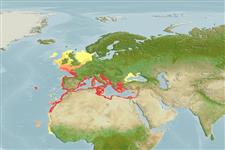>
Eupercaria/misc (Various families in series Eupercaria) >
Sparidae (Porgies)
Etymology: Pagellus: Diminutive of Latin, pager, derived from Greek, pagros = a fish, Dentex sp. (Ref. 45335).
More on author: Linnaeus.
Environment: milieu / climate zone / depth range / distribution range
Ecologia
marinhas bentopelágico; intervalo de profundidade ? - 300 m (Ref. 4781), usually 20 - 100 m (Ref. 4781). Subtropical; 63°N - 10°N, 32°W - 42°E
Eastern Atlantic: Norway and the Mediterranean to Guinea-Bissau (Ref. 26999), including Cape Verde, Madeira and the Canary Islands. Rarely recorded in Scandinavia (Ref. 4781).
Comprimento de primeira maturação / Tamanho / Peso / Idade
Maturity: Lm 14.2, range 13 - 16 cm
Max length : 60.0 cm SL macho/indeterminado; (Ref. 4781); common length : 25.0 cm SL macho/indeterminado; (Ref. 4781); peso máx. publicado: 3.2 kg (Ref. 40637)
Espinhos dorsais (total): 12; Raios dorsais (total): 10-11; Espinhos anais 3; Raios anais : 8 - 9. Body red without stripes or bars. Snout at least twice as long as the eye diameter (Ref. 35388).
Found on inshore waters, on various bottom (rock, gravel, sand and mud) to 200 m (Mediterranean) or 300 m (Atlantic) and move to deeper waters during winter. Omnivorous, but feed mainly on benthic invertebrates and small fishes (Ref. 3688). Protogynic hermaphrodites, females become males first in their third year with sizes of about 17 cm. Important food fish.
Possibly two spawning periods in the southern Mediterranean (Ref. 4781). Length at which sex change possibly occurs is between 12.8 and 20.3 cm FL (Ref. 57849).
Bauchot, M.-L. and J.-C. Hureau, 1990. Sparidae. p. 790-812. In J.C. Quero, J.C. Hureau, C. Karrer, A. Post and L. Saldanha (eds.) Check-list of the fishes of the eastern tropical Atlantic (CLOFETA). JNICT, Lisbon; SEI, Paris; and UNESCO, Paris. Vol. 2. (Ref. 3688)
Status na Lista Vermelha da UICN (Ref. 130435)
Ameaça para os humanos
Reports of ciguatera poisoning (Ref. 4690)
Uso pelos humanos
Pescarias: espécies comerciais; peixe esportivo: sim
Ferramentas
Relatórios especiais
Baixar XML
Fontes da internet
Estimates based on models
Preferred temperature (Ref.
123201): 12.2 - 21, mean 17.2 °C (based on 492 cells).
Índice de diversidade filogenética (Ref.
82804): PD
50 = 0.5156 [Uniqueness, from 0.5 = low to 2.0 = high].
Bayesian length-weight: a=0.01000 (0.00901 - 0.01109), b=3.02 (2.99 - 3.05), in cm total length, based on LWR estimates for this species (Ref.
93245).
Nível Trófico (Ref.
69278): 3.5 ±0.1 se; based on diet studies.
Generation time: 6.1 (5.4 - 7.3) years. Estimated as median ln(3)/K based on 18
growth studies.
Resiliência (Ref.
120179): médio(a), tempo mínimo de duplicação da população 1,4 - 4,4 anos (K=0.24; tm=1-2; tmax=13; Fec=31,000).
Prior r = 0.47, 95% CL = 0.31 - 0.78, Based on 13 stock assessments.
Fishing Vulnerability (Ref.
59153): Moderate vulnerability (40 of 100).
Climate Vulnerability (Ref.
125649): Moderate vulnerability (41 of 100).
Nutrients (Ref.
124155): Calcium = 101 [50, 194] mg/100g; Iron = 0.546 [0.317, 0.919] mg/100g; Protein = 19.7 [18.6, 20.9] %; Omega3 = 0.384 [0.256, 0.577] g/100g; Selenium = 88.3 [41.4, 196.7] μg/100g; VitaminA = 8.36 [2.06, 37.61] μg/100g; Zinc = 0.449 [0.331, 0.672] mg/100g (wet weight); based on
nutrient studies.
